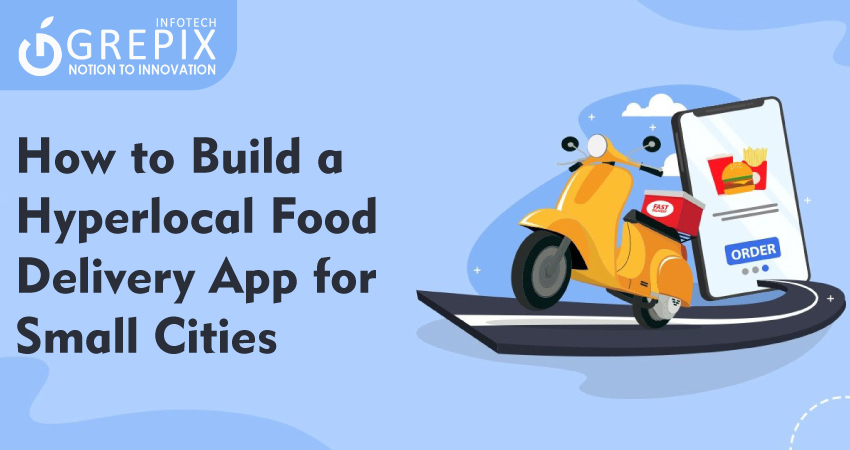How to Build a Hyperlocal Food Delivery App for Small Cities
Building a hyperlocal food app for small cities in 2025 is a transformative opportunity for local businesses and aspiring entrepreneurs. This comprehensive guide will help anyone aiming to launch a hyperlocal food app, a local food delivery clone, or a small city delivery app understand the benefits, challenges, and essential strategies for succes
The demand for hyperlocal food apps in small cities is surging, driven by smartphone penetration, changing consumption patterns, and the desire for convenience. Hyperlocal food app solutions connect customers with neighborhood restaurants and vendors for fast, reliable delivery within city limits. This guide explores the unique benefits and challenges of launching a local food delivery clone in small markets. Covered topics include logistics, technology, app features, and business models designed for small city delivery app startups. The right strategy enables local businesses to flourish, improves customer choices, and builds community. From ideation to scaling, learn how to navigate the evolving delivery ecosystem and lay the groundwork for long-term success.
1How to Build a Hyperlocal Food Delivery App for Small Cities
Hyperlocal Food App Market Trends
Why Now?
- The hyperlocal food delivery market is expected to reach nearly $487 billion by 2035, growing at more than 6.8% CAGR.
- Global smartphone and internet penetration drive hyperlocal business models even in Tier 2, Tier 3 towns.
- The COVID-19 pandemic accelerated consumer preference for contactless, home-delivered meals.
Growth in Smaller Cities
- Hyperlocal services are expanding beyond metros, opening major opportunities in small cities and rural areas.
- Increased local business participation widens food choices and speeds up delivery.
- Market estimates forecast hyperlocal models in smaller cities driving double-digit annual growth over the next decade.
2What is a Hyperlocal Food App?
hyperlocal food app connects users with local food vendors, restaurants, and delivery partners within a specific geographic zone (often within a few kilometers) for ultra-fast, same-day, or even hour-based delivery.
- Local food delivery clone: A white-label or cloned app that mimics successful delivery apps, tailored for local markets.
- Small city delivery app: Platforms built for smaller towns optimizing routes, localized offers, and partner onboarding.
Key Characteristics:
- Focus on proximity (neighborhood/pincode-based delivery)
- Real-time geolocation, inventory, and dispatch
- Targeted digital marketing for local customer acquisition
3Why Target Smaller Towns with a Local Food Delivery Clone?
Market Opportunity
-
Over 50% of India’s food app orders in 2025 came from non-metro regions, a trend mirrored in the US, Europe, and emerging markets.
Expansion fuels growth for local businesses, home kitchens, and cloud kitchens otherwise sidelined by large national delivery giants.
Benefits for Businesses
- Increased local order volume and revenue.
- Access to customer analytics for tailored marketing.
- Reduced competition vs major city markets.
Benefits for Users
- Greater choice and diversity of cuisine.
- Shorter wait times than traditional delivery.
- Support for local businesses—boosts the neighborhood economy.
4Benefits of a Hyperlocal Food App in Small Cities
- Boosts local economies drives orders to small restaurants, home chefs, and grocery shops.
- Logistics are cheaper and more efficient due to shorter delivery radii.
- Customers get better, faster, and more personalized service.
- Fosters community loyalty and local brand affinity.
Also Read: "Cloud Kitchens and Food Delivery Apps: A Perfect Match"
5Main Challenges for Small City Delivery App Startups
Logistics & Last-Mile Delivery
- Fewer delivery partners or lack of professional delivery networks.
- Need for optimized, cost-efficient delivery route planning.
Vendor Onboarding
- Many local outlets lack tech awareness, digital menus, or online payment capability.
User Acquisition & Education
- In small cities, customers may be new to food delivery apps requires community-based promotion and trust-building.
- Addressing cash-on-delivery and local language support.
Retention and Repeat Orders
- Small populations mean higher reliance on loyalty programs and referral incentives to boost order frequency.
6How to Build a Hyperlocal Food App: Step-by-Step
Market Research & Ideation
- Survey food habits and local business readiness.
- Map existing supply chains, local cuisines, and customer pain points.
Choose the Right Hyperlocal Model
- Single-store Model: Exclusive to a restaurant or chain greater quality control, but limited variety.
- Marketplace/Aggregator Model: Onboards multiple local partners greater menu selection, higher delivery complexity.
- Store Pick Model: Third-party drivers pick up food from different local outlets drives flexibility but requires strong inventory syncing.
Design User-Centric App Features
- Essential Features for a Small City Delivery App:
- User registration, account management, and address input
- Live order tracking, push notifications
- Multi-language support, including local dialects
- In-app chat or call for customer service
- Secure payments (cards, digital wallets, and cash on delivery)
- Ratings, reviews, and loyalty/reward programs
- Analytics dashboard for vendors
Build the Technology Stack
- For local food delivery clone: Use open-source frameworks or ready-made app templates for low-cost, quick launch.
- For custom development: Partner with app agencies for tailored solutions (higher cost, but more control).
Vendor & Delivery Partner Onboarding
- Digitize local menus, enable item inventory syncing.
- Offer training or onboarding sessions for local business partners.
- Set up a rider/delivery network partner with local scooter/bike owners.
Pilot Launch & Community Marketing
- Begin in small geographic zones or neighborhoods.
- Use referral bonuses, introductory offers, and local events.
- Collaborate with community groups for trust and reach.
Scale Operations
- Integrate AI tools for route optimization and demand forecasting.
- Expand into nearby towns or districts as user and vendor engagement grows.
- Continuously seek feedback and iterate features.
7Hyperlocal Food App vs. National Players
| Feature | Hyperlocal Food App | National Apps |
|---|---|---|
| Delivery Radius | 2–8 km (localized) | 10–50+ km (citywide) |
| Vendor Diversity | Local, niche, exclusive | Mostly major brands |
| Speed | Ultra-quick (within hours) | Same-day/late-night |
| Personalization | High (offers, language) | Low-medium |
| Customer Support | Local, direct | Centralized, impersonal |
| Delivery Partner Network | Local residents/scooters | Large fleets |
| Community Engagement | Strong | Minimal |
8Essential Tech for Hyperlocal Food Apps
Geofencing & Location Tracking
- Delivers real-time ETA and accurate delivery routes.
- Enables location-based promotions and community campaigns.
Inventory Synchronization
- Syncs live inventory between app and vendors, reducing "out of stock" cancellations.
- Enables real-time menu updates.
AI-Driven Logistics
- Smart batching of orders, route optimization, and demand prediction.
Payment & Loyalty Integrations
- Enable digital wallets, UPI, and cod options.
- Reward repeat customers with discount codes and referral credits.
9Marketing a Small City Delivery App
Community-First Strategy
- Partner with local influencers and neighborhood groups for early trust.
- Sponsor local festivals, college events, and town activities.
Hyper-Personalized Offers
- Use app analytics to fuel time-bound deals based on weather, festivals, or local trends.
- Run city- or locality-specific campaigns to attract and retain users.
Word-of-Mouth & Referral Bonuses
- Incentivize users to invite friends and family.
- Implement sharing tools and exclusive launch offers.
10Common Pitfalls and How to Avoid Them
- Ignoring Vendor Experience: Streamline onboarding, provide support, and help local outlets digitize.
- Underestimating Logistics: Use AI and local driver partnerships to ensure timely deliveries even in low-density regions.
- Lack of Local Customer Support: Provide direct lines, fast responses, and agents who know local nuances.
- Minimal Marketing: Go beyond digital ads network at community events and offer hyper-targeted deals.
Conclusion
Launching a successful hyperlocal food app local food delivery clone, or small city delivery app unlocks immense opportunities for local businesses, aspiring entrepreneurs, and underserved communities. With the hyperlocal food app market set for multi-billion-dollar growth, there has never been a better time to leverage proximity-driven logistics, community trust, and digital convenience in smaller towns. Overcoming local challenges logistics, vendor onboarding, and community trust demands a tailored mix of technology, marketing ingenuity, and focused vendor partnerships.
Today’s small city delivery apps are about more than just convenience; they're engines for community growth, economic empowerment, and next-level customer experience. If you’re ready to transform local business and capture the next food delivery wave, start planning a local food delivery clone now. Share this guide with partners, gather feedback from your town, and make your vision for a thriving, hyperlocal food ecosystem a reality
FAQs
1. What is a hyperlocal food app?
A hyperlocal food app connects users with local restaurants or stores to deliver food within a limited geographic radius, focusing on ultra-fast, neighborhood-based service.
2. How does a small city delivery app differ from metro delivery apps
Small city delivery apps serve tighter areas, rely on community-based networks, and prioritize personalization, unlike metro apps that often operate at scale with major chains.
3. How profitable is launching a local food delivery clone in a small city?
With low logistical costs, high vendor participation, and less competition, profitability is strong if the app maintains consistent order volume and efficient operations.
4. Is it necessary to offer cash on delivery in smaller towns?
Yes, many users in small towns still prefer cash payments, making it critical for trust-building and conversion rates.
5. What technology stack works best for hyperlocal food app development?
Open-source platforms and modular app templates are cost-effective, but custom solutions are better for unique features or scalability.
Launch your vision with our mobile app development company, where innovation meets excellence to create cutting edge mobile solutions.







